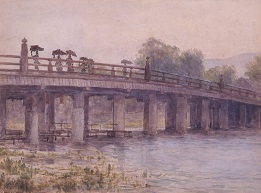Curatorial StudiesCuratorial Studies 07: (Japanese western-style painting)
and Ukiyo-e - Japonisme as Mirror
Curatorial Studies 07: (Japanese western-style painting)
and Ukiyo-e - Japonisme as Mirror
HOME > Exhibitions > The 4th Collection Gallery Exhibition 2014-2015 > Curatorial Studies 07: (Japanese western-style painting) and Ukiyo-e - Japonisme as Mirror
(Japanese western-style painting) and Ukiyo-e - Japonisme as Mirror

In the exhibition entitled "Curatorial Studies 07: Yôga (Japanese western-style painting) and Ukiyo-e - Japonisme as Mirror," we try to consider how Japanese western-style painters dealt with this question which was deeply related to their own raison d'être, by utilizing "Ukiyo-e" as a medium.
Even though Japanese art gave inspiration to Western artists in various ways, we focus on screen composition which shows significant influence from ukiyo-e. Among all, by utilizing 4 distinctive compositions characteristic to ukiyo-e, such as "bridge," "boat," "grove," and "combing hair," we studied respective compositions in the following three cases: original ukiyo-e paintings, western paintings supposedly influenced by ukiyo-e, and Japanese western-style paintings which were supposedly influenced by "ukiyo-e" and/or "western painting."
Many Japanese western-style painters in the early period were well versed in traditional Japanese painting and its painting methods, as represented by artists such as Asai Chu. It is extremely difficult to clarify whether the "ukiyo-e" style composition in their work was derived from original ukiyo-e paintings or western paintings which were influenced by "ukiyo-e." Therefore, the relationship mentioned here is just an example.
However, how the western-style painters and Japanese artists in those days accepted and understood Japonisme gives precious insight into a problem we are facing now. In other words, how those artists at that time reacted to the "returning current of Japonisme," relates to how today's proliferation of Japanese culture abroad as represented by the phrase "Cool Japan" could influence us back here in Japan.
It would give us great pleasure if this project could become the starting point for a new, contemporary approach.
Planning and coordination by
Ikeda Yuko (Curator, MoMAK) & Hirai Yoshinobu (Assistant Curator, MoMAK)
Academic support by Takashina Erika, Ph. D., Associate Professor,
Institute for Research in Humanities, Kyoto University
Ikeda Yuko (Curator, MoMAK) & Hirai Yoshinobu (Assistant Curator, MoMAK)
Academic support by Takashina Erika, Ph. D., Associate Professor,
Institute for Research in Humanities, Kyoto University
Top of this page


